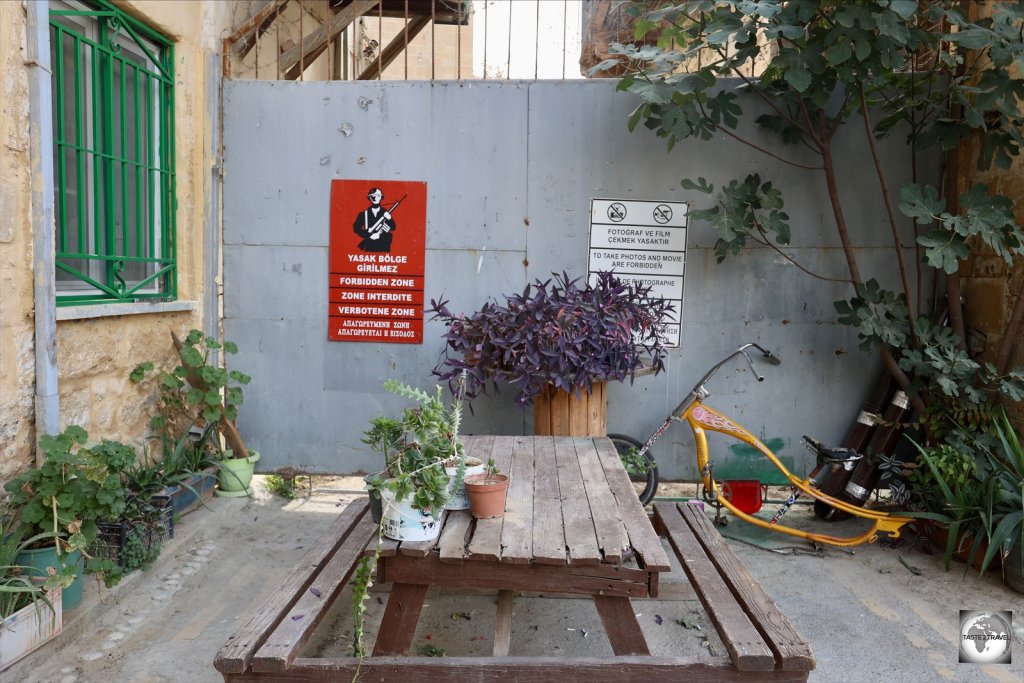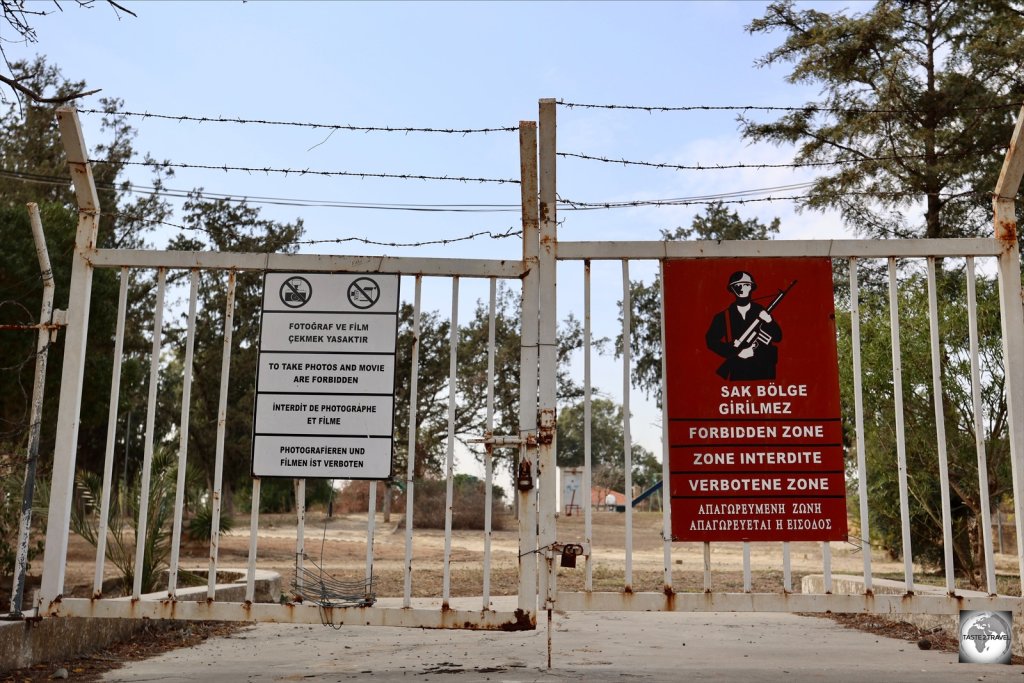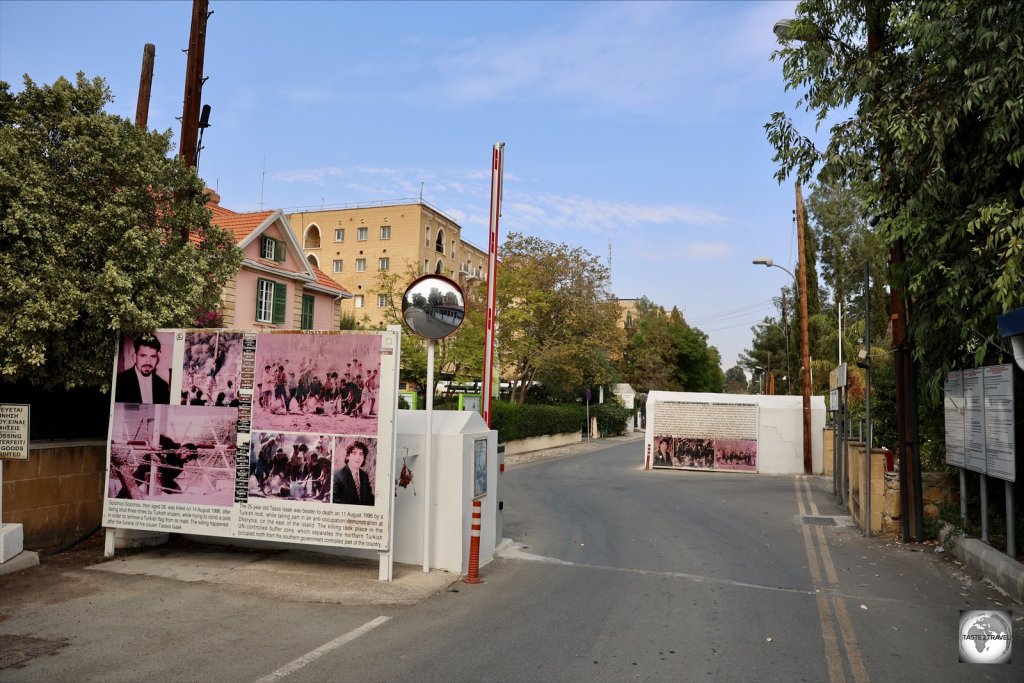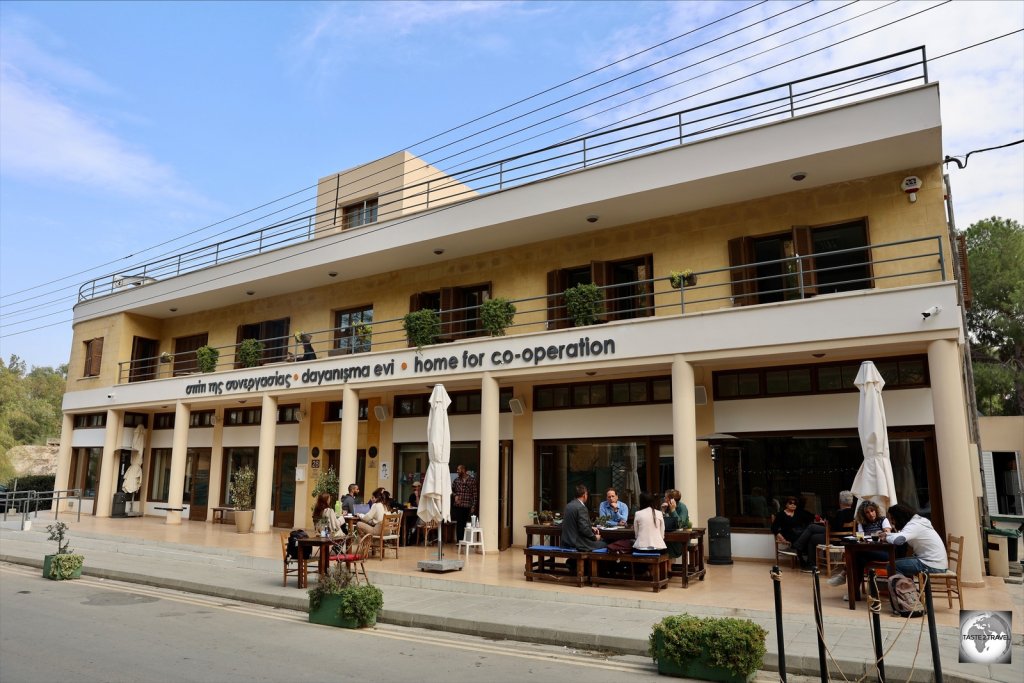Northern Cyprus Travel Guide
This is a Northern Cyprus Travel Guide from taste2travel.
Date Visited: November 2021
Introduction
Often overlooked by the hordes of tourists which descend upon the modern, (Greek) Republic of Cyprus, the Turkish Republic of Northern Cyprus (TRNC) is a much quieter backwater, a charming version of a more traditional Cyprus.
While the Republic of Cyprus receives an average of 4,000,000 visitors per year (mostly from Europe), TRNC receives around 1,000,000 visitors per year, with about 900,000 of those coming from Turkey.

A map of Cyprus which shows Northern Cyprus in yellow.
Source: Nations Online Project.
Following intercommunal violence in 1974, which saw the Greek Cypriot majority fighting against the Turkish Cypriot minority, Turkey invaded Cyprus, annexing the top third of the island, creating a safe haven for Turkish Cypriots. After almost 50 years, this division remains, and shows no sign of ending anytime soon.
Separating the two sides is the UN Green Line – so named after the original dividing line was drawn on a map using a green pen.
The only country which recognises the TRNC is Turkey. Due to its lack of recognition, Northern Cyprus is heavily dependent on Turkey for economic, political and military support.

A view of Kyrenia port.
Not flush with funds itself, and facing its own financial issues, Turkey has provided minimal investment into Northern Cyprus since its invasion in 1974.

A makeshift barrier on the Greek side of the UN Green Line blocks a street in the old town of Nicosia.
Meanwhile, across the UN Green Line, a much more confident, cosmopolitan and modern, Republic of Cyprus, joined the European Union on the 1st of May 2004.

Garden furniture outside a residential building in North Nicosia softens the effect of the steel wall of the UN Buffer zone.
At the time, the EU wanted a united Cyprus to join the Union. However, despite joining the EU as a de-facto divided island, the whole of Cyprus is considered EU territory, with Turkey as an occupier. EU law is suspended in areas where the Cypriot government (Government of the Republic) does not exercise effective control.
Membership of the EU, and generous EU subsidies, has allowed the Republic of Cyprus to develop at a much faster rate than the TRNC.
Passing through a UN Green Line checkpoint from the Greek to the Turkish side of the island is like passing through a worm-hole, transporting you from a modern, 21st century, 1st world experience to a 20th century, 2nd world experience.

A highlight of North Nicosia, Büyük Han is an Ottoman-era caravanserai which dates from 1572.
Despite the differences TRNC is a charming destination, home to historic towns, medieval castles, vast archaeological sites, beautiful beaches and a capital city with a distinct Ottoman feel.
The use of the weaker Turkish lira as the official currency also makes the TRNC a much cheaper travel destination, compared to the more expensive Greek side of the island, which uses the Euro (€).
Important Note:
If you enter TRNC from Turkey, you will not be able to cross the UN buffer zone into southern Cyprus, nor will you be able to depart from any airport in the south.
This is due to the fact that TRNC is not recognised by the international community and as such, entering Cyprus through TRNC is not recognised as a valid entry point.
If you enter TRNC from Turkey, you will have to exit TRNC back to Turkey.
Location
North Nicosia, Nicosia
Northern Cyprus occupies the top one third of the island of Cyprus, which is located in the Eastern Mediterranean Sea 75 kilometres (47 mi) south of Turkey and 97 kilometres (60.3 mi) west of Syria.
History

Overlooking the north coast of Cyprus, Kantara castle dates from the Byzantine period.
Famous as the mythical birthplace of the goddess Aphrodite, Cyprus was first settled by Mycenaean Greeks in the 2nd millennium BC.
Due to its location at the crossroads of many ancient empires, Cyprus was subsequently occupied by the Assyrians, Egyptians and Persians, from whom the island was seized in 333 BC by Alexander the Great.
Following in the footsteps of Alexander, Cyprus was occupied by the Egyptians, the Roman Empire, the Arab caliphates, and eventually by the Ottomans who ruled the island over three centuries between 1571 and 1878.

A view of the interior of Kumarcilar Han, an Ottoman-era caravanserai (inn), located in North Nicosia old town.
Prior to the Ottoman conquest of 1571, there were no Muslims living permanently on Cyprus. At the time of the Ottoman takeover, about 30,000 Turkish settlers were resettled on Cyprus.
During the years of Ottoman rule, the migration of Turkish (Muslim) settlers to Cyprus, from Anatolia (modern day Turkey), continued, forever changing the ethnic makeup of Cyprus and laying the seeds for the ethnic conflict which would eventually result in the island being divided.

An old ‘GR’ (George Royal) post box in Famagusta serves as a reminder of the British colonial period.
Following the Ottoman period, Cyprus became a British colony. Known as British Cyprus, the island formed part of the British Empire from 1878 to the 16th of August, 1960 at which point the island became independent.
At the time of independence, Cyprus had a total population of 573,566; of whom 442,138 (77.1%) were Greeks, 104,320 (18.2%) Turks, and 27,108 (4.7%) were other nationalities.
A power-sharing arrangement between the Greek and Turkish sides quickly fell apart, resulting in legal impasses and discontent on both sides. Nationalist militants started training, with the military support of Greece and Turkey respectively.
Intercommunal violence erupted on the 21st of December 1963, when two Turkish Cypriots were killed at an incident involving the Greek Cypriot police. Intercommunal violence ensured and, in 1964, Turkey threatened to invade Cyprus in order to protect the Turkish minority.

An abandoned Greek Cypriot home in the Northern Cyprus village of Kantara.
On the 15th of July 1974, the Greek military junta carried out a coup d’état, to unite Cyprus with Greece.
Turkey then launched an invasion, seizing the top third of the island and creating the Turkish Republic of Northern Cyprus (TRNC) as a safe zone for Turkish Cypriots.

Now off limits, a former park on the city walls in North Nicosia is now part of the UN Buffer zone.
As a result of this action, Greek Cypriots who lived in the north of Cyprus, were forced to abandon their homes and relocate south of the dividing line, while Cypriot Turks in the south moved north.
People
At the time of partition in 1974, Turkish Cypriots, who lived all over Cyprus, were forced to relocate north of the UN Green Line into what is now Northern Cyprus. Many chose to leave Cyprus instead!
Likewise, Greek Cypriots, who lived throughout the island, were forced to relocated south of the UN Green Line. It’s estimated that 162,000 Greek Cypriots were forcibly evicted from their homes in the North by the invading force of the Turkish army.
This mass relocation resulted in many properties being abandoned. Today, these properties remain shuttered, and in legal limbo, ghostly reminders of an unresolved conflict.
Today, Northern Cyprus is home to more than 326,000 Turkish Cypriots, with 99% practicing Islam. However, much larger numbers live abroad with the diaspora found in countries such as Turkey (300,000), the United Kingdom (130,000), Australia (30,000) and Canada (6,000).
Flag

The flags of Turkey and Northern Cyprus inside the Saint Peter and Paul Church (Sinan Pasha Mosque) in Famagusta.
The flag of Northern Cyprus is based on the flag of Turkey, with the colours reversed and two additional horizontal red stripes at the top and bottom. Adopted in 1984, the stripes indicate Turkey (top) and Northern Cyprus (bottom).
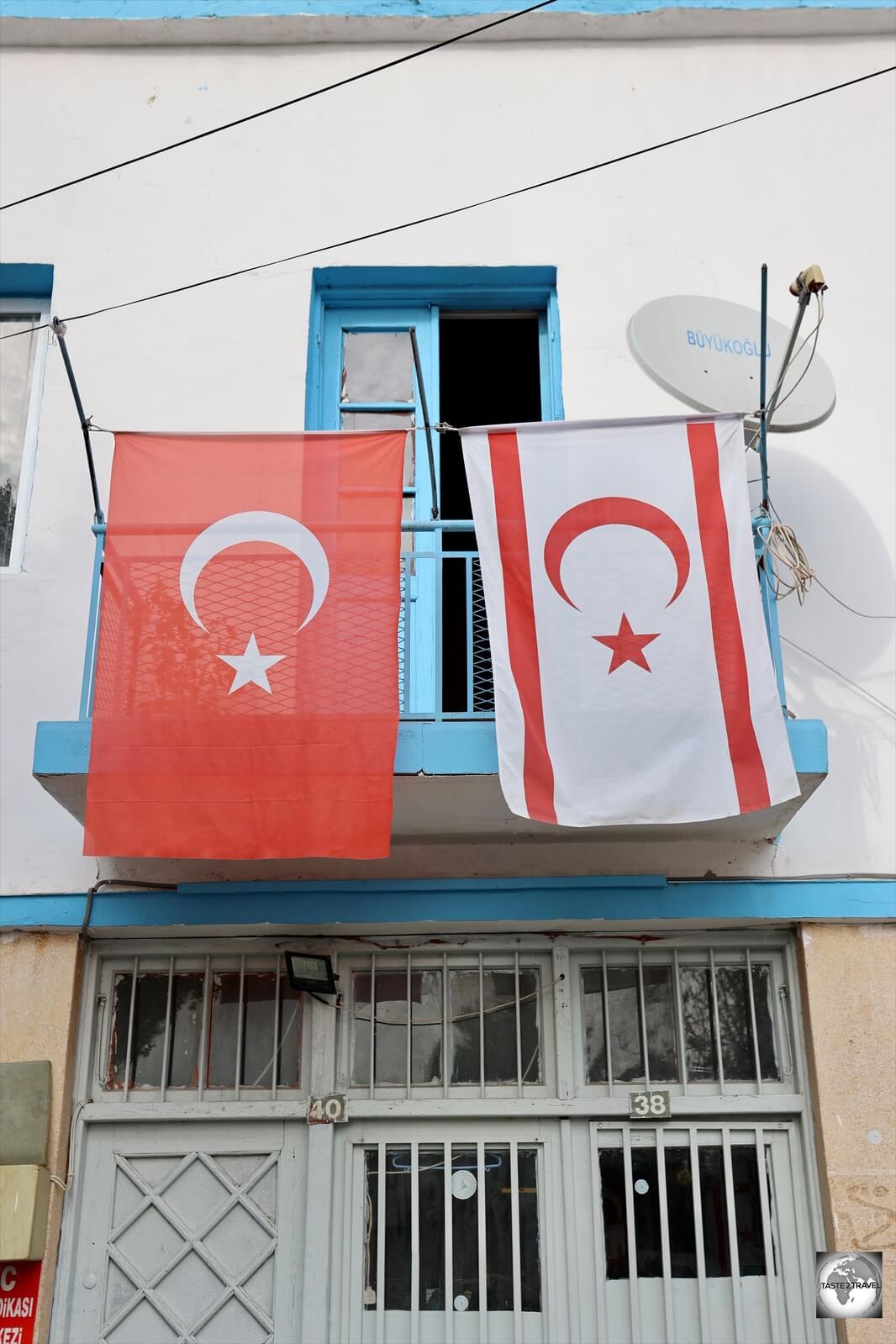
Hanging from the balcony of a house in North Nicosia, the flag of Turkey always flies alongside the flag of Northern Cyprus.
Everywhere throughout the TRNC, the flag of Turkey flies alongside the flag of Northern Cyprus.

Located on the slopes of the Kyrenia Mountains, a giant flag of Northern Cyprus covers an area of four football fields, and is clearly visible from the Greek side of the island.
Even before you cross into Northern Cyprus, a TRNC flag looms large on the horizon, clearly visible from space and, more importantly for the TRNC government, from the Greek side of the island.
Located on the slopes of Mount Pentadaktylos (Turkish: Beşparmaklar Mountain), the highest point on the Kyrenia mountain range, a flag the size of four football fields can be seen from across the UN Green Line in Nicosia.
Illuminated at night, the flag was first lit up on Greek National Day on the 28th of October, 2003. Today, this massive flag is a permanent reminder of a divided island and considered a provocation by the Greek Cypriots.
Special teams from Turkey regularly bring in red and white dyes to maintain the flag, which appears next to a slogan from Kemal Ataturk, the founding father of modern Turkey: “How happy is he who calls himself a Turk!”
Currency
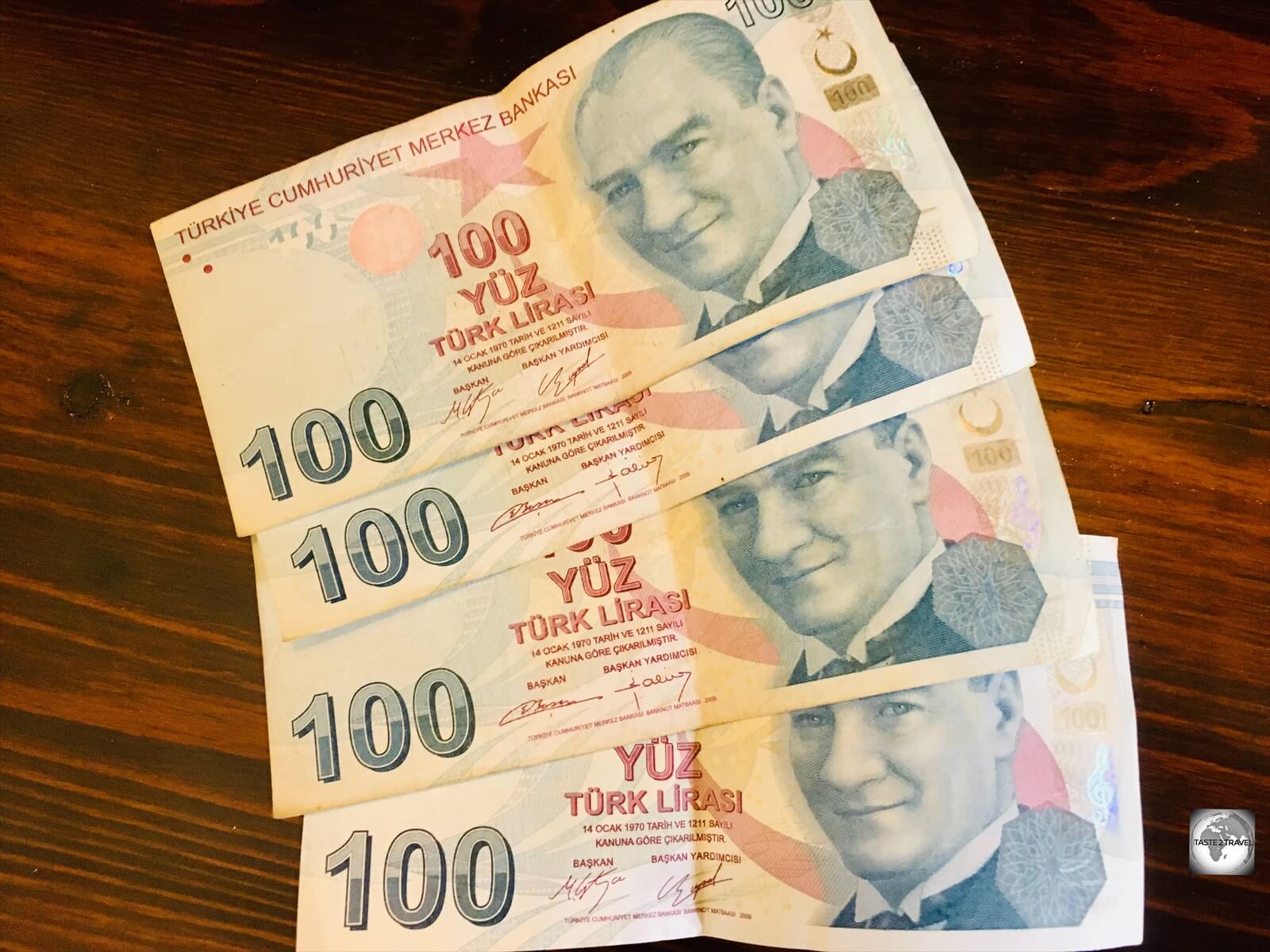
The official currency of Northern Cyprus is the Turkish Lira.
The currency of Northern Cyprus is the Turkish Lira, although it should be the Euro!
Northern Cyprus is legally part of the EU, but EU law is suspended due to the north being under the control of the Turkish Republic of Northern Cyprus, which the EU does not recognise.
As a consequence, the currency of Turkey, the only state to recognise the TRNC, is the de-facto currency, although the Euro circulates freely.
The Turkish lira (international currency code: TRY, but usually abbreviated as TL) is the currency of Turkey and Northern Cyprus. One Turkish lira is subdivided into one hundred kurus.

All Turkish Lira banknotes feature the smiling face of Kemal Atatürk, the father of modern Turkey.
In recent times, the lira has been weakening, which has resulted in cheaper prices for visitors, but increasing prices for locals.
Exchange Rates
Did you know? Due to the ever-weakening Turkish Lira, property leases in Northern Cyprus are often denominated in either US$, Euro (€) or Pound Sterling (£).
Of course, locals don’t have access to hard currencies and so must pay their rents in Turkish lira at the current (ever-weakening) exchange rate. Ouch!
Bad news for tenants, great news for landlords who receive ever-increasing rental income.
Shopping

The streets of downtown Kyrenia are lined with bottle shops which offer famous alcohol brands at bargain prices!
Northern Cyprus is a shopper’s paradise, offering a range of international items at bargain prices.
The streets of downtown Kyrenia are lined with branded boutiques and scores of bottle shops which offer famous brands of alcohol at prices far below airport Duty Free shops.

A sign in a Burberry outlet in Kyrenia illustrates the conundrum which is TRNC!
How cheap is alcohol in Northern Cyprus? The following prices were being charged by bottle shops in Kyrenia at the time of my visit (November 2021):

Bottle Shop prices in Kyrenia, Northern Cyprus.
- Absolut Vodka 70 cl: 94 TL (US$6.77)
- Bombay Sapphire Gin 70 cl: 150 TL (US$10.84)
- Tanqueray Gin 70 cl: 180 TL (US$12.97)
- Jack Daniels 70 cl: 170 TL (US$12.25)
- Jack Daniels 1L: 220 TL (US$15.86)
- Jim Bean 1.5L: 180 TL (US$12.97)
- Olmeca Tequila Gold 1L: 215 TL (US$15.50)
Costs

A Litre of unleaded fuel in Northern Cyprus cost me 9.14 TL (€0.58)
With most things denominated in (the very weak) Turkish lira, costs in Northern Cyprus are much cheaper than in neighbouring Cyprus where Euro prices are much higher.
While shopping is a bargain; meals, drinks, fuel and almost everything else is much cheaper in TRNC. The two exceptions are hotel and car rental rates which are comparable to Cyprus.
Fuel prices are especially cheap in Northern Cyprus with a litre of unleaded petrol costing 9.14 TL (€0.58), while over the border in Cyprus, the same litre of fuel costs €1.32! No wonder many Greek Cypriots cross the border to refuel their cars.
Sample costs:
- Meal (inexpensive Restaurant): 25 TL (€1.60)
- Efes Beer (330-ml bottle): 6 TL (€0.38)
- Cafe Latte at Mensure’s Coffee & Chocolate in Kyrenia: 23 TL (€1.47)
- Chocolate dessert at Mensure’s Coffee & Chocolate in Kyrenia: 40 TL (€2.56)
- Coca Cola (330-ml bottle): 7 TL (€0.45)
- Water (330-ml bottle): 5 TL (€0.32)
- Hotel room at the Sofia Boutique Hotel in Kyrenia: 860 TL (€55.00)
- Rental Car (daily rate): 375 TL (€24.00)
- Unleaded petrol (1 litre): 9.14 TL (€0.58)

A 70 cl bottle of Absolut Vodka for 94 TL (€6. 00)? Alcohol is especially cheap in Northern Cyprus!
Sightseeing
North Nicosia
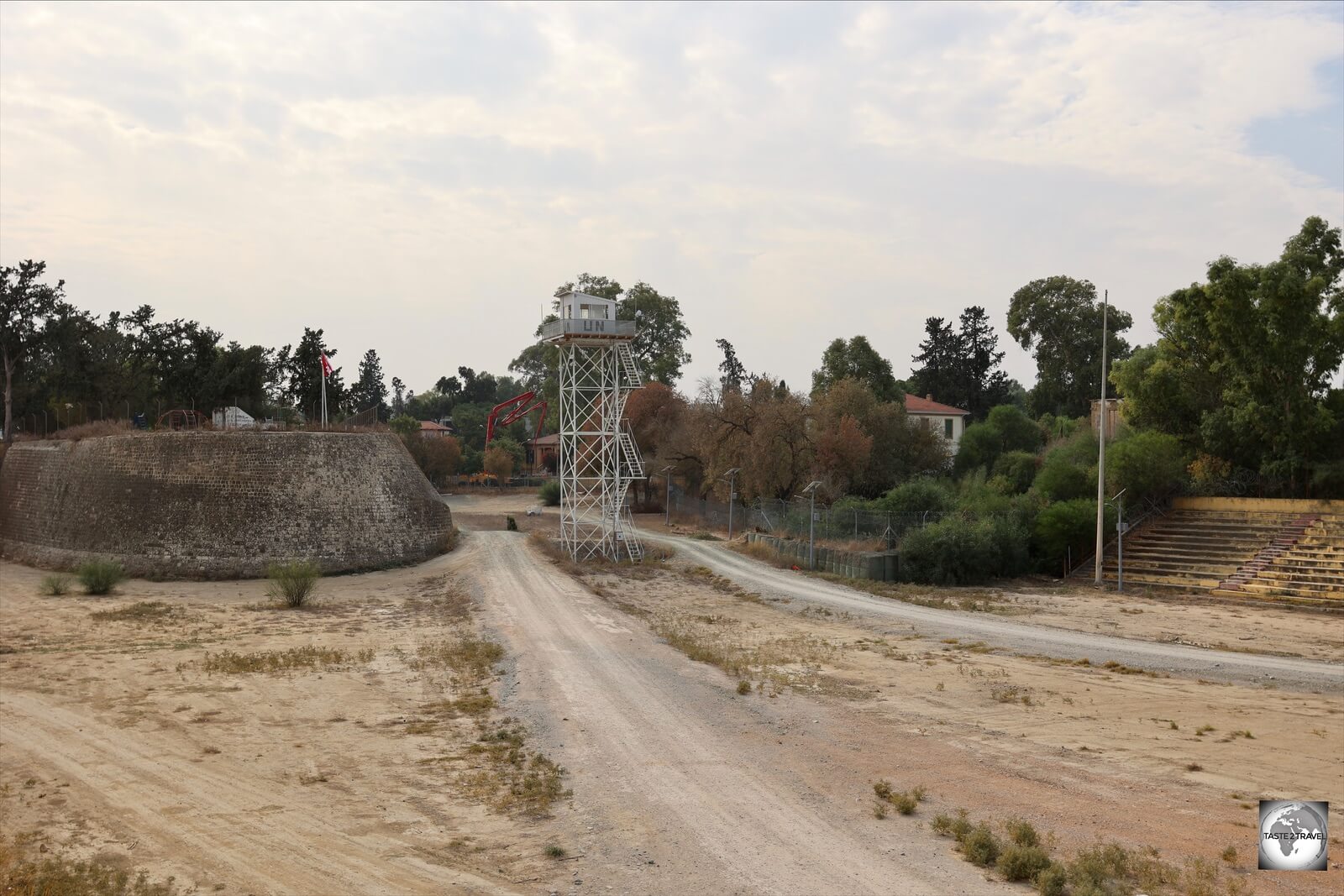
Former medieval fortifications which were originally built to defend Nicosia are now used to divide the city.
Nicosia (Turkish: Lefkoşa) is the largest city, capital, and seat of government of Cyprus. It has the distinction of being the southeasternmost of all EU member states’ capitals.
The city has been continuously inhabited for over 4,500 years and has been the capital of Cyprus since the 10th century. Today North Nicosia is the capital of Northern Cyprus, a state recognized only by Turkey, that is considered to be occupied Cypriot territory by the international community.
UN Green Line
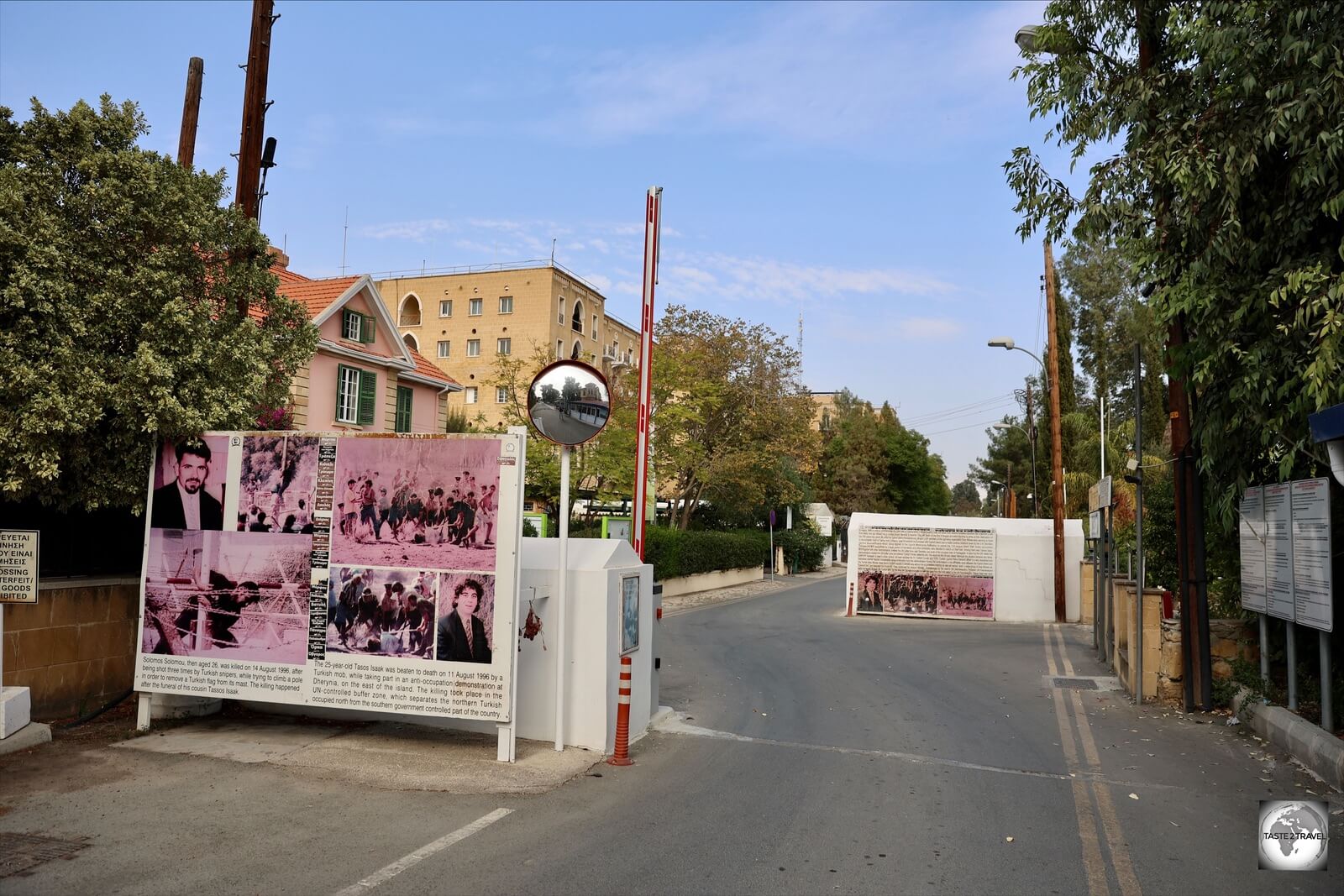
A view of the Greek side of the Ledra Palace crossing point in Nicosia.
The Greek Cypriot and Turkish Cypriot communities of Nicosia segregated into the south and north of the city respectively in early 1964, following the fighting of the Cyprus crisis of 1963–64 that broke out in the city.

Frozen in time, an abandoned building inside ‘no-mans-land’ still bears the scars of battle.
This separation became a militarised border (UN Green Line) between the Republic of Cyprus and the Turkish Republic of Northern Cyprus (TRNC) after Turkey invaded the island in 1974, occupying the north of the island, including northern Nicosia.

Ottoman-era homes in North Nicosia overlook the medieval fortifications which now form part of the UN Buffer zone.
At its heart, Nicosia old town is enclosed by a circular defensive wall which was built by the Venetians in the 16th century. With a circumference of 5 km (3 miles), the wall contains eleven pentagonal bastions.
The UN Green Line bisects this circular enclosure, with the Greek half of the old town to the south and the Turkish half to the north. The two main crossing points lie within the walled old town. Despite many attractions, the biggest tourist draw is the UN Green Line.

A map showing a divided Nicosia.
Source: BBC.
Despite its many attractions, the biggest tourist draw in Nicosia is the eerie UN Green Line – also known as the UN Buffer zone.

A sign in Nicosia old town warns against entering the UN Buffer zone.
Within Nicosia, the UN Green Line is an almost total exclusion zone and is contained behind high walls, metal gates, barbed wire and concrete-filled oil drums.

A former residential building on the UN Buffer zone in Nicosia is boarded up to prevent unauthorised entry into the zone.
The Green Zone is policed by United Nations troops, amid barbed wire and dilapidated buildings with sand bags still sitting in the windows.
Either side of this dividing line, whole city blocks lay abandoned since 1974, frozen in time, stuck inside ‘no-mans-land’ with former residents and business owners locked out until a solution can be found to reunite the island.

A laneway in North Nicosia is blocked by a section of wall which includes a ladder and two peep holes.
Either side of this dividing line, whole city blocks layed abandoned since 1974, frozen in time, stuck inside ‘no-mans-land’ with former residents and business owners locked out until a solution can be found to reunite the island.
Often, while walking through the maze of laneways in the old town, your way is blocked by a section of the buffer zone.

A residential building in North Nicosia lies directly on the UN Green Line.
After almost 50 years of division, residents on both sides of the buffer zone have become use to living with a hard border passing through their front gardens.
Some have installed garden furniture or sit and play backgammon or chat in streets which have become quiet cul-de-sacs due to access being blocked by the wall.

Residents on the Greek side of the UN Green Line sit and chat in front of a section of wall.
Selimiye Mosque

Selimiye Mosque is a former Christian cathedral converted into a mosque under the Ottomans.
North Nicosia’s most prominent landmark, which can also be seen from the Greek side of the city, the Selimiye Mosque started life in 1209 as a Christian cathedral.
After 78 years of construction, the cathedral was consecrated in 1326 as the Church of Agia Sofia (meaning “Holy Wisdom” in Greek). It was the largest church in the eastern Mediterranean and was used as the coronation church of the kings of Cyprus.

When the Agia Sofia cathedral was converted into a mosque by the Ottomans, minarets were installed in place of the bell towers.
When the Ottomans arrived in 1571, they stripped the building of its Christian contents and added two minarets, between which the Turkish Cypriot and Turkish flags now flutter.

At the time of my visit, the Selimiye Mosque was closed for renovations.
At the time of my visit in November 2021, the mosque was closed for extensive renovations.
Büyük Han

A view of Büyük Han, an Ottoman-era caravanserai which dates from 1572.
Lying at the heart of North Nicosia old town, Büyük Han, is an Ottoman-era caravanserai.

Giftshops occupy the many rooms of Büyük Han, a former caravanserai.
One of the first building projects by the Ottomans, construction of Büyük Han was commenced in 1572 by the first Ottoman governor of Cyprus, Lala Mustafa Pasha. It served as an inn for travellers.

A view of Büyük Han, one of the main sights of North Nicosia.
The building was renovated in the early 1990s and is today a tourist magnet, offering cafes, restaurants and workshops which are housed in the small cells leading off the 1st-floor balcony that originally served as the inn’s sleeping areas.

North Cyprus postcards for sale at a giftshop inside Büyük Han.
Kumarcılar Han

An Ottoman-era Caravansarai in the heart of North Nicosia old town, the Kumarcilar Han is surrounded by cafés and restaurants.
This caravanserai is a smaller version of the neighbouring Büyük Han and was built in the early 18th century. Today its courtyard hosts cafes, and the surrounding cells, where merchant goods were once stored, are today home to local craft shops.
Ottoman Architecture

The streets of North Nicosia old town are lined with Ottoman-style buildings.
One of the noticeable differences between the Greek and Turkish sides of Nicosia are the number of beautifully restored Ottoman-style buildings which line the streets of North Nicosia old town.
Oddly, there are very few Ottoman-style buildings remaining on the Greek side of the city!
Nicosia Market

The covered market in North Nicosia offers everything from plastic combs, souvenirs to produce.
No Turkish city is complete without a covered market and North Nicosia market lives up to all expectations. Located around the corner from the Selimiye mosque, the market is housed inside a huge, sprawling hall and is an Aladdin’s cave of everything imaginable.
From plastic combs to fresh produce, souvenirs and Cyprus (Turkish) delight, the market is a great place to shop!
Kyrenia (Girne)

A very golden statue of Kemal Atatürk, the father of modern Turkey, graces the waterfront in Kyrenia.
The northern port city of Kyrenia (Turkish: Girne) is the main tourist hub of North Cyprus, offering a good selection of accommodation, shopping, sightseeing, dining and entertainment options. This is the place to base yourself with all other cities within daytrip distance.
Kyrenia Castle

Kyrenia castle guards the entrance to Kyrenia harbour.
Built during the Byzantine period, the large looming hulk that is Kyrenia castle guards the narrow entrance to Kyrenia harbour.

A view of Kyrenia harbour from Kyrenia castle.
A large rectangular structure, the castle contains a cistern, dungeon, chapel and two small museums, including the fascinating Shipwreck Museum.

The flags if Turkey and Northern Cyprus flying on top of the ramparts at Kyrenia castle.
A highlight of the castle is a walk (sometimes precarious), along the top of the ramparts, which offers panoramic view of Kyrenia harbour and the old town – the best views in town.
Shipwreck Museum
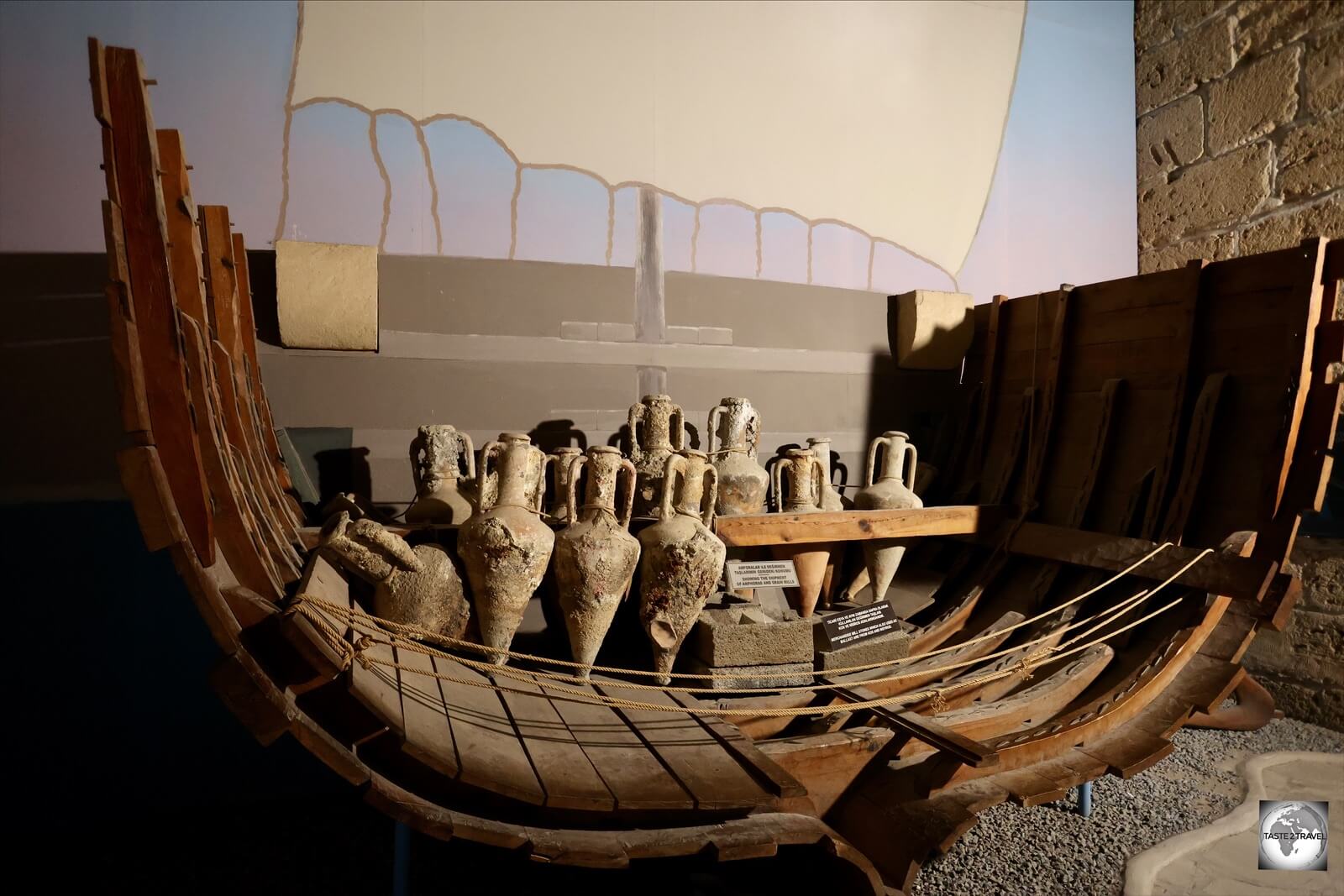
The Kyrenia Shipwreck Museum contains the remains of the oldest shipwreck recovered from Cypriot waters.
Housed inside one of the castle ramparts, the Kyrenia Shipwreck Museum contains the remains of the oldest shipwreck recovered from Cypriot waters.
Built of Aleppo pine, this Greek merchant ship sank off the Kyrenia coast around 300 BC, and was discovered by a local diver in 1967.
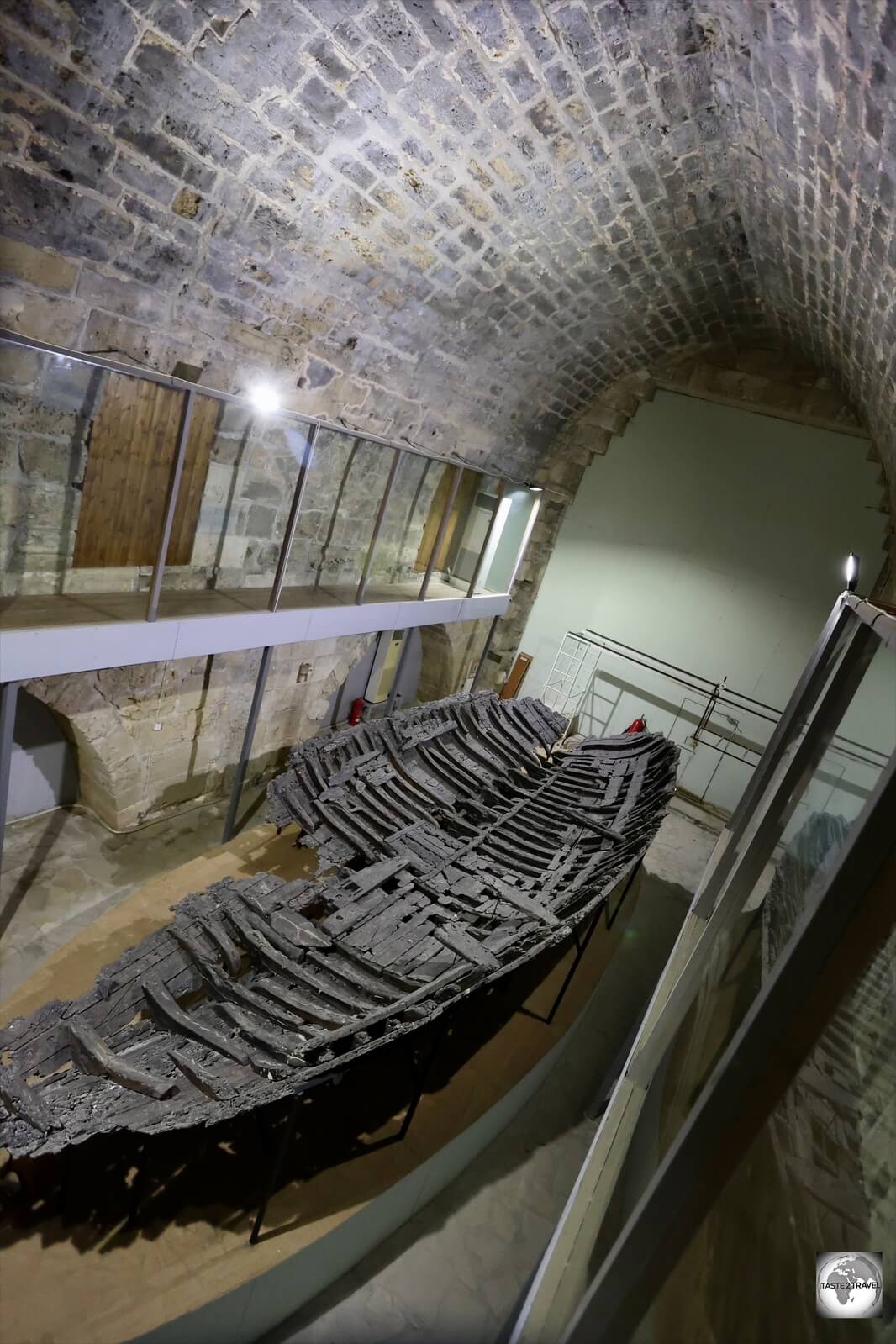
The recovered wooden hull of the Greek merchant ship which sunk in 300 BC.
Its cargo consisted of amphorae (ancient vessel form used as a storage jar), almonds, grain, wine and millstones from the Greek islands of Samos, Rhodes and Kos. In an upstairs room is the remains of the wooden hull.
Bellapais Abbey

Bellapais Abbey is a highlight of Kyrenia.
Founded in the early 13thC by the Augustinian friars who had been evicted from the city of Jerusalem, after it fell to Saladin, Bellapais Abbey was established under Aimery Lusignan who ruled Cyprus from 1194-1205.
The abbey consists of a church and a cloister, with most of the monastic buildings surrounding the cloister. The name “Bellapais” derives from the French name “Abbaye de la paix” which means “Abbey of Peace”.
Located on a hill, 6 km south-west of Kyrenia town, Bellapais is home to the only functioning church in Northern Cyprus – the church of Ayia Asprophorusa, “Our Lady of the White Garments”.

A view of the interior of Ayia Asprophorusa church at Bellapais Abbey.
While all other churches in Northern Cyprus were converted into mosques during the Ottoman period, the small church of Ayia Asprophorusa was deemed to be of such importance that it was spared!
The church was once said to have been endowed with a piece of the True Cross from Jerusalem, a gift from a crusading Knight. This relic was stolen by invading Genoese in the 14th century.

Ayia Asprophorusa church at Bellapais Abbey was converted into an orthodox church.
Built in the 13th century building, the church is the oldest surviving building of the abbey. It has three aisles and inside the church there are chandeliers and impressive arches with pillars that support the roof.

The altar of Ayia Asprophorusa church, the only functioning church in Northern Cyprus, where 99% of the population are Muslim.
After the Ottomans conquered Cyprus, they handed Bellapais monastery to the Orthodox Church. The Orthodox Church only made small changes, mainly to the interior of the church. They added features like the wooden altar and icons.

A view of the cloister at Bellapais Abbey.
The beautiful, 18-arch, cloister and the refectory surrounding the courtyard area were completed between 1324 and 1359 AD. There are several stairs from the cloisters which provide access to the roof from where you have sweeping views of the north coast and Kyrenia.

A Byzantine column in the Chapter House at Bellapais Abbey.
Located on the eastern side of the cloister, the Chapter House functioned as the abbey’s administrative section. The column in the centre of the Chapter house may have come from a Byzantine church.
Saint Hilarion Castle

Saint Hilarion castle offers panoramic view of Kyrenia and the north coast of Cyprus.
Saint Hilarion Castle lies on the Kyrenia mountain range, directly overlooking the port city. This strategic location provided the castle with command of the pass road from Kyrenia to Nicosia.
It is the best-preserved ruin of the three former strongholds in the Kyrenia mountains, the other two being Kantara and Buffavento.
Constructed in the 11th century by the Byzantines, Saint Hilarion Castle was part of a defensive system, together with the castles of Buffavento and Kantara, to guard the island against Arab pirate attacks.

A view of Kyrenia from Saint Hilarion Castle.
Used as a summer residence by the ruling Lusignans, the castle was divided into three sections, with the lower and middle sections serving economic purposes, while the upper section housed the royal family.
Today, the Turkish army maintains a military base (one of many in Northern Cyprus) nearby along with firing ranges and other practice areas. Photography along the approach road to the castle is forbidden (guards maintain watch over passing motorists) but, once at the castle, you have a clear view of their installations and photography isn’t a problem.
Kantara Castle

Kantara Castle occupies a lofty position high in the Kyrenia mountain range.
Another of the defensive installations, Kantara Castle is located at an elevation of 550–600 metres (1,800–1,970 ft) above sea level, in the Kyrenia mountain range, 66 km east of Kyrenia.

Kantara Castle is located at an elevation of 550–600 metres (1,800–1,970 ft) above sea level.
While the exact date of its construction remains unknown, although most probably during the Byzantine period, the castle became derelict in 1525 and was dismantled in 1560.

Perched on a high peak in the Kyrenia mountains, Kantara castle offers sweeping views of the north coast of Cyprus.
The castle is surrounded by ridges of barren granite and sandstone bedrock which were used as the main building materials for the castle’s construction.

A view of the Kyrenia mountain range, looking east towards the panhandle of Cyprus.
The lack of local water sources necessitated the collection of rainwater through the use flat roofs which were connected to the cisterns through a drainage system.
Famagusta
City Walls

A view of the western side of the immense city walls which surround Famagusta. A pathway now lies in the former moat.
Nowhere else in Cyprus is the heavy burden of history so apparent than in the port city of Famagusta (Turkish: Gazimağusa).
With its old town completely surrounded by huge walls which were built by the Venetians during the 15th- and 16th-century, Famagusta draws a steady stream of tourists who make day trips across the UN Buffer zone from nearby Larnaca and Ayia Napa.
During the Middle Ages, Famagusta was the island’s most important port city and a gateway to trade with the eastern Mediterranean ports, from where Silk Road merchants carried their goods to Western Europe.

A gateway in the city walls of Famagusta.
Dating from 274 BC, Famagusta is nicknamed “the city of 365 churches” owing to a legend that at its peak, Famagusta boasted one church for each day of the year.
When the Ottomans took control of the city after a long battle with the ruling Venetians, all Christians were expelled from the city and were replaced by settlers from Anatolia.
In the following years, the many churches were either destroyed or converted to mosques.
Today, Famagusta’s star has fallen with many buildings in the old town closed or abandoned. While it makes for a great day trip, Famagusta old town offers few accommodation and dining options and is very quiet in the evenings, once all the day trippers have left. Famagusta is located 61 kilometres (38 miles) south-east of Kyrenia.
Lala Mustafa Pasha Mosque (St. Nicholas Cathedral)

Consecrated in 1328, St. Nicholas cathedral was converted into the Lala Mustafa Pasha Mosque after the Ottoman Empire captured Famagusta in 1571.
The Lala Mustafa Pasha Mosque, originally known as the Saint Nicholas Cathedral is the largest medieval building in Famagusta.
Built between 1298 and 1400, it was consecrated as a Catholic cathedral in 1328. The cathedral was converted into a mosque after the Ottoman Empire captured Famagusta in 1571 and it remains a mosque to this day.
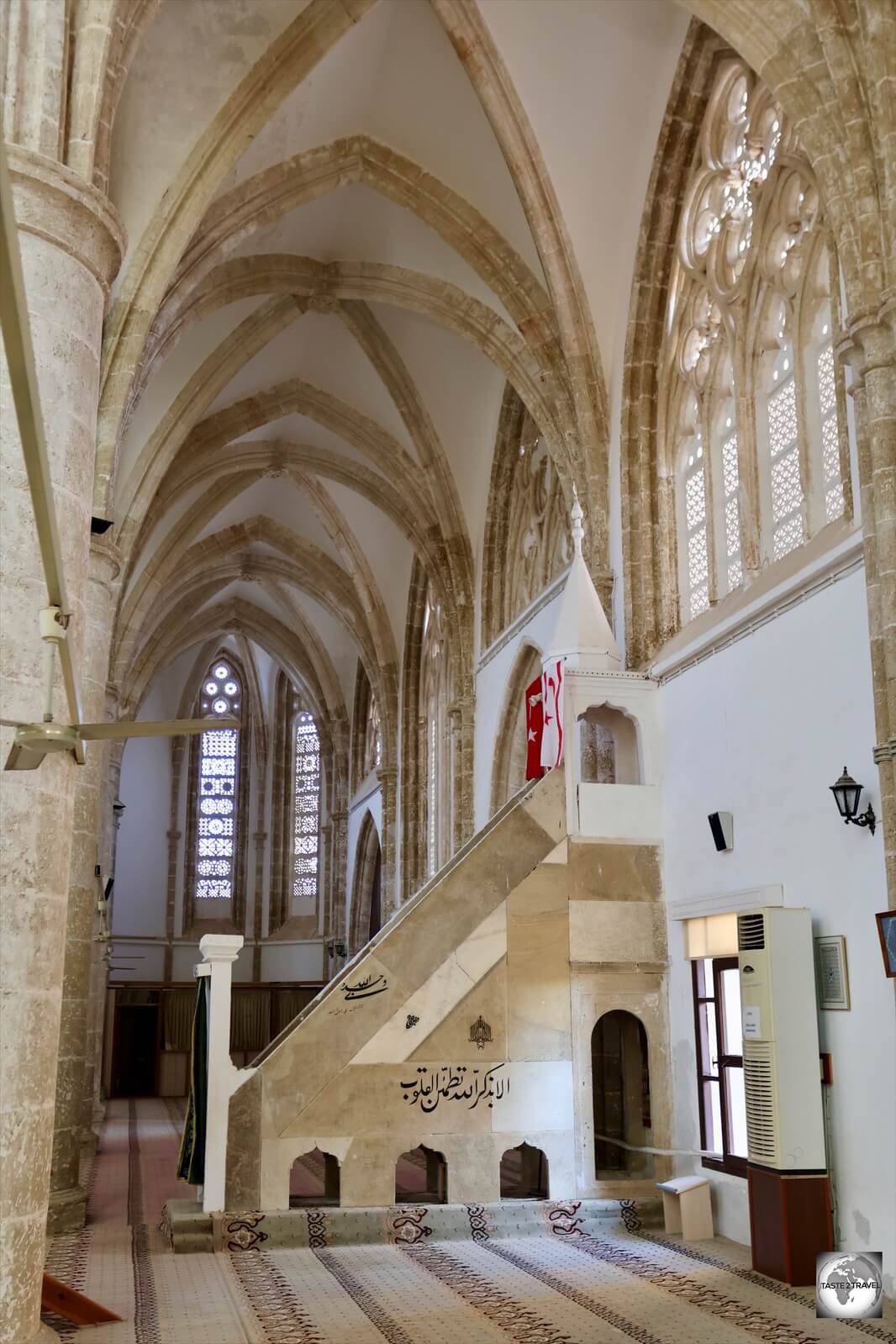
A view of the mihrab inside Lala Mustafa Pasha Mosque, formerly St. Nicholas cathedral, Famagusta.
At the time of its conversion to a mosque, nearly all statuary, stained-glass and other artworks were removed or plastered over, as well as most tombs and the altar. A minaret was added to one of the former bell towers.
A large mihrab (facing Mecca) has been installed on the southern wall of the former church, which completely changes the orientation of the building.

A view of the vaulted ceiling inside Lala Mustafa Pasha Mosque.
The Gothic structure, including the impressive vaulted ceiling, was preserved, although the interior is now very minimal with all pews removed and replaced by carpet.
Sinan Pasha Mosque (Saint Peter and Paul Church)

Due to its height, the walls of the Sinan Pasha Mosque (Saint Peter and Paul Church) are supported by flying buttresses.
Originally consecrated in 1359 as the Saint Peter and Paul church, this massive structure was financed with funds donated by a successful merchant. Because of its height, the church walls had to be supported by impressive flying buttresses.

A worshipper inside the Sinan Pasha Mosque, formerly the Saint Peter and Paul church.
The building became disused during the Venetian period, as it escaped the attention of the Ottoman bombardment of the city in 1571. After their conquest, the Ottomans added a minaret to the south west corner (since destroyed) and renamed the edifice Sinan Pasha Mosque, after “Sinan the Great” who served five times as Grand Vizier in the Ottoman empire.
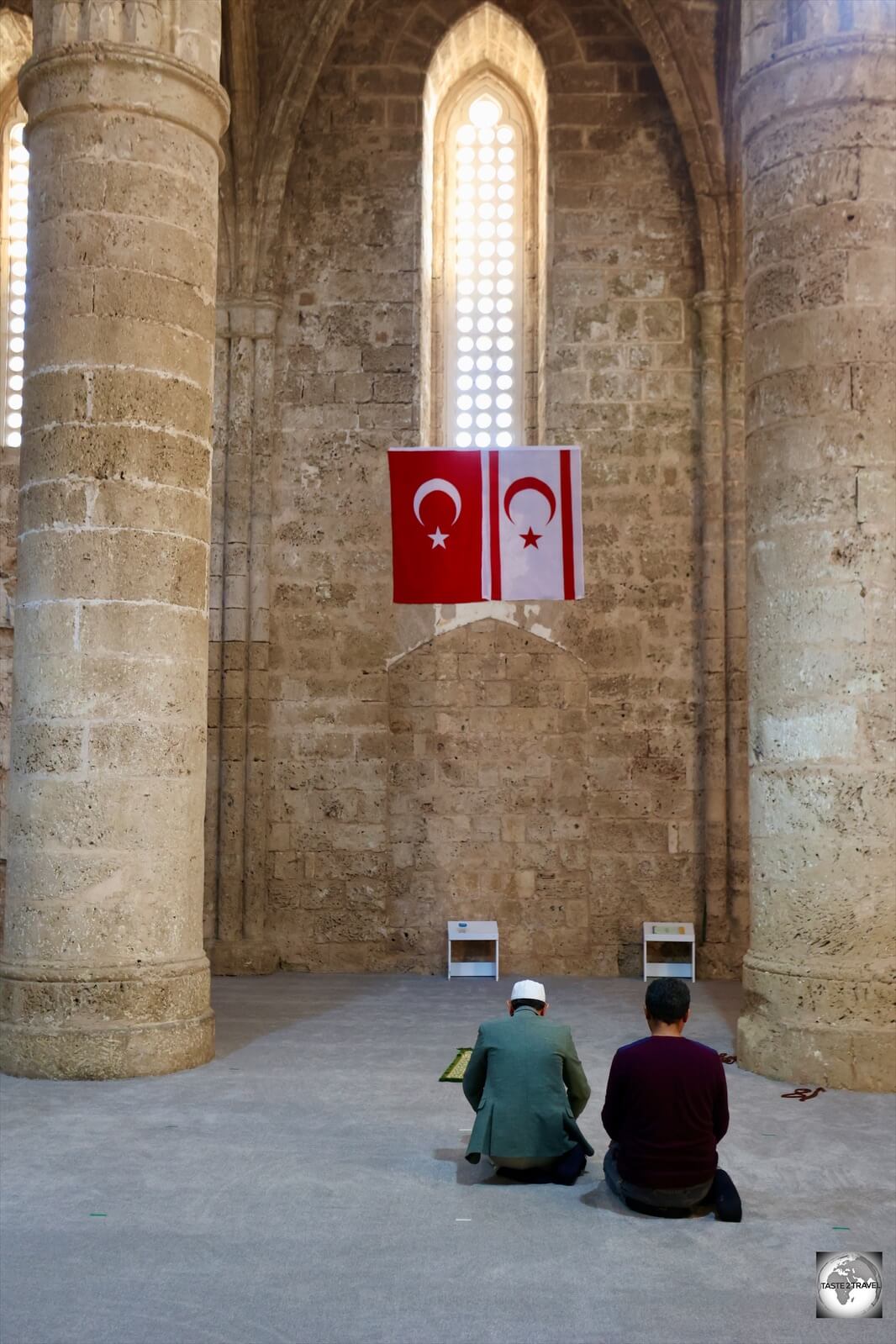
Worshippers inside the Sinan Pasha Mosque in Famagusta.
During the British era of the island, the mosque was used as a potato and grain store and so is also locally referred to as the “Bugday Cami” (wheat mosque).
Like the nearby Lala Mustafa Pasha Mosque, the interior of the former church has had all religious artwork removed and is now very minimal with just a mihrab installed on the southern wall underneath the flags of Turkey and Northern Cyprus.
St. George’s of the Greeks Church

The ruins of St. George’s of the Greeks church in Famagusta.
Consecrated in 1360, and today a magnificent ruin, the Church of St. George of the Greeks is believed to have been the seat of Famagusta’s Orthodox bishopric during medieval times.

A view of the former interior of St. George’s of the Greeks church in Famagusta.
Although structural unsound, with a roof that was too heavy for the supporting columns, the church stood for little over one hundred years and was destroyed during the Ottoman siege of Famagusta in 1571.
Accommodation

The pool and breakfast area at the Sofia Boutique Hotel in Kyrenia.
The best range of accommodation options in Northern Cyprus are to be found in the tourist hub of Kyrenia.
While hotel options exist in North Nicosia and Famagusta, the picturesque port city of Kyrenia is the place for shopping, dining and entertainment, with everything open late into the evening.
I stayed at the wonderful Sofia Boutique Hotel (room rate 860 TL/ €55.00) which is located at 7 Atilla Street in the heart of Kyrenia old town, a 3-minute walk from the old port and castle.

My room at the Sofia Boutique hotel in Kyrenia.
Each of the nine rooms at the Sofia Boutique hotel are nicely decorated, featuring cosy interiors which are welcoming and homey.
While situated in the heart of Kyrenia old town, a short walk from the dining and entertainment hub around the port, the hotel is an oasis of calm and serenity.

Breakfast at the Sofia Boutique hotel in Kyrenia.
Breakfast, which is made to order, is served each morning poolside.
A high level of service was provided by the small team of staff who had emigrated to Northern Cyprus from CIS countries such as Russia, Turkmenistan and Kazakhstan. It seems Northern Cyprus is an employment destination of choice for those nationalities who would have difficulty gaining an EU work visa.
I enjoyed my stay at the Sofia Boutique hotel and look forward to visiting again! The hotel is a real gem and one I would highly recommend!
Eating Out

The interior of a colourful café in the old town of North Nicosia.
While Cyprus may be a divided island, when it comes to cuisine, the island is very much united!
The same, delicious, food which is served on the Greek side of the island is also to be found on the Turkish side, with a standard meal consisting of grilled meat, fresh salad, grilled halloumi and fresh, warm, flat-bread.
Where the cuisine of the TRNC differs slightly from the Greek side is the presence of Turkish restaurant chains.
Restaurants

A view of the TRNC checkpoint on Ledra Street, North Nicosia, from the Simit Dünyası restaurant.
North Nicosia
One popular Turkish restaurant chain – Simit Dünyası – serves delicious food from its North Nicosia branch, which is located directly opposite the TRNC (Ledra Street) checkpoint.

A grilled halloumi sandwich for lunch at Simit Dünyası in North Nicosia, with the TRNC checkpoint in the background.
As soon as you exit the Turkish side of the crossing, your first stop should be this restaurant/ café. The first thing you’ll notice is the price difference, compared to the, more expensive, Greek side.
Offering a front row view of the Turkish side of the Ledra Street checkpoint, it’s not often you can sit and enjoy lunch while watching the comings and goings of a border crossing. Photography of the checkpoint isn’t a problem!
Most visitors to Northern Cyprus are day-trippers who walk across the Ledra Street crossing to spend a day shopping and eating in the old town of North Nicosia.
The streets of the old town are lined with cafés and restaurants, all serving tasty food at very reasonable prices.
A bridge-builder in a divided city and a unique dining experience!

The ‘Home for Co-operation’ restaurant and café offers a unique dining location inside the UN Buffer zone in Nicosia.
For a truly unique dining experience, it’s hard to beat the Home for Co-operation restaurant and café, which is located inside the UN Buffer zone, opposite the abandoned Ledra Palace hotel in downtown Nicosia.
Where else in the world do you have the opportunity to dine inside ‘no-mans-land’?
Open Monday to Friday from 9:00 to 21:00, the Home for Co-operation acts as a meeting place for people from both sides of the buffer zone. Signs on either side of the buffer zone provide directions to the cafe which is an institution in the divided capital.
To access this uniquely placed café, you simply need to present your passport at either the Greek or Turkish checkpoints which lie just 100-metres from the café.
In addition to serving freshly roasted coffee and tasty meals, the Home for Co-operation also features exhibitions and provides meeting spaces for people from either side of the buffer zone to work on collaborative projects.
A beacon of hope in a divided city!
Cafés
North Nicosia

Café No.3 is located a short walk from the Ledra Street crossing in North Nicosia.
The streets of North Nicosia old town are lined with traditional Ottoman-style houses which are home to both retro and modern cafés and restaurants. One popular cafe is Café No.3 which is located a short walk from the Ledra Street checkpoint.

Located in the heart of North Nicosia old town, the Kumarcilar Han is the setting for many cafes and restaurants.
Located in the heart of North Nicosia old town, the beautifully restored Kumarcilar Han (Gambler’s Inn), an Ottoman-era Caravansarai, is the setting for many cafes and restaurants.
Famagusta
Located within the walled old town of Famagusta, Petek Pastanesi is famous all over Cyprus for its divine pastries and sweets, including a tempting selection of Cyprus (Turkish) delight. This is an ideal place for lunch or coffee and cake in between visiting the many ruined churches of Famagusta.
Kyrenia
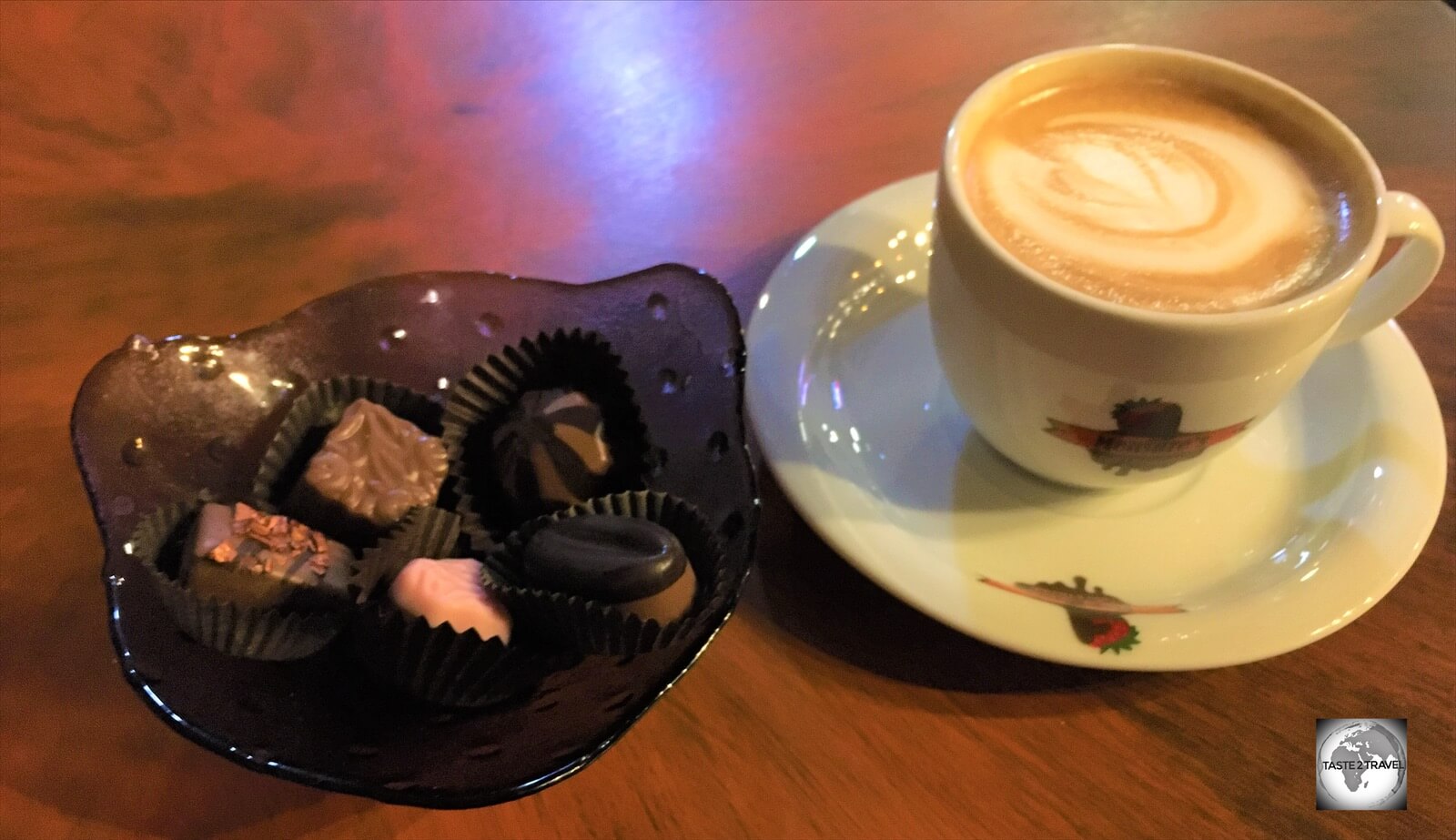
A selection of very affordable hand-made chocolates at Mensure’s Coffee & Chocolate café in Kyrenia.
For those who appreciate hand-made chocolates and good coffee, the ground floor of the Sofia Boutique hotel in Kyrenia is occupied by the delectable Mensure’s Coffee & Chocolate café.
With a warm and inviting interior, soft, calm music (Sade is especially popular!) and relaxed ambiance, this emporium of sweetness is a great place to unwind.
The menu features both sweet and savoury options but is especially strong on chocolatey desserts. The perfect accompaniment to a coffee, hand-made Belgium chocolates, which cost about €0.20 each, are offered in a variety of flavours.
Bars

A great place for sunset drinks, the rooftop bar at the White Pearl Hotel in Kyrenia offers a panoramic view of the old port and castle.
Kyrenia
There are many bars in Northern Cyprus, with most serving inexpensive Turkish beer and cheap, international-brand spirits.
A large concentration of bars can be found around the old port in Kyrenia. A favourite place for sunset viewing was the rooftop bar at the White Pearl hotel, which overlooks the port.

The view of Kyrenia port and castle from the rooftop bar at the White Pearl Hotel in Kyrenia old town.
The brainchild of Birol Bebek, a local professional photographer, this groovy, chilled space, serves cold Turkish beers and fabulous cocktails to the sound of mellow jazz classics.
A great place to watch the sunset and the flurry of activity in the restaurants below.
Visa Requirements

A view of the main crossing point (from the Greek Cypriot side) on Ledra Street, Nicosia.
Almost everyone is entitled to a 30-day tourist visa which is issued without fuss at either Ercan International airport or any of the land crossings. If you can provide proof of booked, long-term, accommodation, you can apply for a 90-day tourist visa.
Click here to view the current TRNC visa policy.
At the time of my visit, extra requirements were in place due to the ongoing Covid-19 pandemic, with a vaccination certificate and a negative ART (Antigen Rapid test) required.
No passport stamps are issued by TRNC immigration and no visa documents are provided. Instead, entry and exit records are recorded by TRNC immigration on a computer database.
Crossing the UN Green Line in Nicosia is a very straight-forward affair, requiring just your passport. Greek officials are very casual with formalities because they don’t recognise TRNC. As far as they are concerned, you are simply crossing to an occupied part of Cyprus.

Tourists in Nicosia (Greek side) photographing across the UN Green Line.
On the TRNC side, they are a little more serious but they love welcoming the steady stream of tourists which visit. Most visitors to the TRNC are day-trippers who walk across the UN Green Line and spend a day shopping and eating in North Nicosia (much cheaper than the Greek side). Most visitors do not stray beyond the walls of North Nicosia old town which is unfortunate!
Getting There
Air
Flights into Northern Cyprus arrive at Ercan International Airport (IATA: ECN), which is located 13 kilometres (8 miles) east of North Nicosia, 40 kilometres west of Famagusta and 44 kilometres south of Kyrenia.
All flights into and out of Northern Cyprus operate to/ from Turkey.
The following (Turkey-based) airlines operate scheduled services to/from Northern Cyprus:
- AnadoluJet: Adana, Ankara, Antalya, Gaziantep, Hatay, Istanbul–Sabiha Gökçen, Izmir, London–Stansted (via Istanbul)
- Pegasus Airlines: Adana, Ankara, Antalya, Gaziantep, Hatay, Istanbul–Sabiha Gökçen, Izmir, London–Stansted (via Istanbul)
- SunExpress: Izmir
- Turkish Airlines: Istanbul
Airport Transport
From the airport, bus services are offered by the Kibhas company to bus stations in the following destinations:
- Kyrenia (Girne)
- Nicosia (Lefkoşa)
- Famagusta (Gazi Mağusa)
- Lefka (Lefke)
- Omorfo (Güzelyurt)
Taxi services can be booked through the Ercan Airport website.
Land

Once the grandest hotel in Nicosia, the abandoned Ledra Palace hotel is frozen in a time-warp, stuck in the middle of no-mans-land in the middle of the UN buffer zone.
There are a total of nine land border crossings between Northern Cyprus and Cyprus, with two being located in downtown Nicosia (Ledra Street and the nearby Ledra Palace Hotel).
Sea
Frequent ferry services between mainland Turkey and Northern Cyprus are operated by Akgunler Denizcilik. With three different vessels (2 slow RO-RO ships and one fast passenger catamaran), the company connects the Turkish port cities of Mersin and Taşucu with Kyrenia and Famagusta.
For reservations and schedules, please refer to the Akgunler Denizcilik website.
Getting Around

A TRNC car license plate.
The best way to maximise your time in Northern Cyprus is with a rental car. The crumbling infrastructure in the north is inferior to the south, where a lack of proper highways makes for much slower journey times.
While car license plates on the Greek side of the island feature three letters and three numbers and a CY designation on the blue EU field, cars from TRNC feature two letters, three numbers and a blue field which contains the seal of the Motor Vehicles Registrar.
Public Transport

Kyrenia Gate in North Nicosia is the main terminus for buses to Kyrenia and other towns.
The backbone of public transport in Northern Cyprus are the many minibuses, which operate on fixed routes from North Nicosia, stopping anywhere along the way to pickup and drop-off passengers.
Buses depart from Kyrenia Gate which is the old northern gateway into Nicosia old town. Prices are inexpensive at approximately 1 TL for trips within the capital and 2.50 TL – 5 TL for inter-city trips. Buses run frequently but to no fixed timetable.
Taxi
There are numerous taxi companies operating in Northern Cyprus with tariffs being very reasonable at 10-20 TL (within town) to 40-70 TL (between towns)
Taxis are often best booked by phone. You can view a list of taxi companies here.
Rental Car

My rental car parked in the village of Kantara.
It should be noted that most rental cars in Cyprus cannot be driven across the UN buffer zone. This is due to insurance coverage being invalid on the other side of the buffer zone.
If you wish to rent a car which can be driven from south to north you should contact one of the larger, international operators such as Hertz or Europcar. I did see Cyprus-registered rental cars from these companies while in Northern Cyprus.
Rental cars from Northern Cyprus cannot be taken across the UN Buffer zone! If you have your own vehicle, you are allowed to take it across the border.
While in the north, I saw many private cars from the south, full of Greek Cypriots visiting the sites of the north or checking on their abandoned properties.
I rented a car through my hotel in Kyrenia, which cost me £20 per day. Car rental rates in Northern Cyprus are normally quoted in Pound sterling.

The license plate of my rental car. All rental car license plates in TRNC are coloured red and prefixed with a ‘Z’.
Speed Cameras
As with everything else in Northern Cyprus, a lack of investment in infrastructure makes for much slower journey times compared to the southern side of the island where EU subsidies have been used to build a modern, fast, highway network.
Most towns in the north are connected by old-style highways which are two-lane main roads with lots of junctions and round-a-bouts. At every single junction you will find an (annoying) speed camera. They are everywhere and often requiring you to slow from 100 km/h to 50, 60 or 70km/h! Cameras occur every few kilometres!
One especially annoying camera is located on a downhill stretch of highway near Kyrenia, requiring you to slow down to 50km/h on a dual carriageway highway. Argh!
That’s the end of my travel guide for Northern Cyprus.
If you wish to provide feedback on this, or any other content on taste2travel, please leave a comment.
Safe Travels!
Darren
Follow me on Instagram:
[instagram-feed feed=1]
Northern Cyprus Travel Guide Northern Cyprus Travel Guide Northern Cyprus Travel Guide Northern Cyprus Travel Guide
Northern Cyprus Travel Guide Northern Cyprus Travel Guide Northern Cyprus Travel Guide Northern Cyprus Travel Guide
Northern Cyprus Travel Guide Northern Cyprus Travel Guide Northern Cyprus Travel Guide Northern Cyprus Travel Guide
Northern Cyprus Travel Guide Northern Cyprus Travel Guide Northern Cyprus Travel Guide Northern Cyprus Travel Guide


























